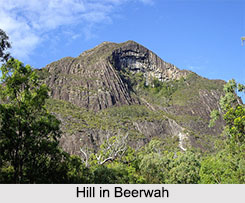 Beerwah in Jammu and Kashmir is a sub district in Central Kashmir. It is one of the oldest tehsils with one of the largest constituency, towns, and municipal areas committees in the Budgam district of the Indian administered Jammu and Kashmir.
Beerwah in Jammu and Kashmir is a sub district in Central Kashmir. It is one of the oldest tehsils with one of the largest constituency, towns, and municipal areas committees in the Budgam district of the Indian administered Jammu and Kashmir.
Naming of Beerwah
The name Beerwah is distorted form of "Bhairwa" which means the "Fairless". There is a another meaning "be roi " which means that the people do not have only one face and is derived from the name for the springs of Beerwah known as "Behroop."
Location of Beerwah
Beerwah is located at a height of 5200 ft above sea level, between 75 degree East longitude and 34 degree North latitude at the base of the Pir Panjal Range. It is surrounded by plains to the north, east, south, and southwest. The village is flanked by a mountain range on its southern side. At the eastern super of this mountain is located the celebrated cave connected with life of Acharya Abinav Gupta, the greatest Lord Shiva or Mahadeva philosopher of Kashmir.
History of Beerwah
In 1766, a fort was built in the region by Governor Lal Mohammad Khatak. It was repaired in 1801 by Governor Abdullah Khan but was destroyed in an earthquake in 1884. The region consisting of Budgam, Beerwah and Baramulla achieved tehsil status as Tehsil Ranbir Singh in 1962, under Sir Syed Sani Mawlana Syed Ali Shah Bukhari. The tehsil of Budgam was split off later in 1979. The region was granted subdistrict status in the 1970s with the support of Mawlana Syed Ali Shah Bukhari, but it was not fully implemented until 2013 by Chief Minister Omar Abdullah and Mirwaiz of Central Kashmir Mawlana Latief Bukhari.
Geography of Beerwah
Beerwah contains forested areas with several mountain rivers and streams, including the Mala Kol, Lear Kol, Ahij Kol, Laen, Zaen, Mean and Sona Mean. The Ahij Kol, Laen and Sona Maen share a source at Sukhnag. The Mala Kol is locally known as the "deaf and dumb stream" due to a legend that when saint Syed Taj-ud-Din arrived in Khag, the stream silently followed him from Sukhnag to Sikandarpora. Local elders continue to tell stories about other local streams. Tosamaidan is a large pasture with a historical background. Bounded by dense forests of deodars, it is situated about 10 km from Khag in the Himalayas. Many countries` shepherds used to visit the area in ancient times, and it was a frequent route for Mughals travelling to Poonch and Punjab. Today the area is frequently used by local shepherds and the Gujjar community. Pehjan is an alpine pasture near the Wular Lake. It features local flowers and plant life and scenic views from the Nanga Parbat peak (26,696 ft). Khag pasture is located in the southwest of Kashmir, 8,000 to 14,000 ft above sea level. It is surrounded by mountains whose average height reaches 17,000 ft. It is frequently scenic in the summer season, when Nomadic Bakarwals bring their cattle to graze. The region has a number of springs of local and tourist significance.
Tourism in Beerwah
Beerwah is home to a number of tourist locales, and the administration is working on a major road connectivity plan to improve regional accessibility. In addition to the springs, pastures, and scenic features of the region, there are markets at Magam, Beerwah, and Narabal. Baba Hanif Dargah, a place of tourist attraction is a ziarat named after peer Baba Hanif is specially visited by pregnant ladies for their well being. Beerwah is the place of springs, green pastures and the peaks of Greater Himalayan Mountain Range. Sutharan is located near Tosamaidan and the Line of Actual Control. According to local legend, (Vanvas) Ram Chander stayed here during his 12-year-long exile with Lakshman and Sita. The spring`s name comes from Sita who is said to have bathed in the spring. Naranag spring, or Narain Nag, is located near the Khag village. According to local legend, an ascetic passing through once dropped a bag full of sheep dung into the lake. When he reached Khag several days later, he saw the dung floating on the surface of the Naranag. He returned to Tosamaidan and sprinkled some turmeric powder into the lake, which appeared in the water in the Naranag. Sukhnag (Sokhanag), known locally as the "spring of solace," cascades in a 20 ft high waterfall at Kanj Zubji. Pushkar Nag is located to the east of Poshker village between Khag and Ferozpora, and is named for the village of its origin. According to local history, during the month of Sawan, Kashmiri Pandits would offer prayers and take a ritual dip in the spring. Some devotees continue to perform the ritual today. Gandhak Nag is a sulphur spring in the Darang Khaipora village of Khag. The healing properties of the sulphur make the spring locally significant. Nakwaer Pal is located near the Pehjan pasture. It is 14,000 ft high and is the highest peak of the range. According to local history, when Kashmir valley was a lake (Sati Sar), boats would be anchored to this rock. Today there is an iron hook within it (Ded Bal), also known as Lal Khanen Gher.
Related Articles
Cities of Jammu and Kashmir
Jammu and Kashmir
Hill Stations of Jammu and Kashmir



















